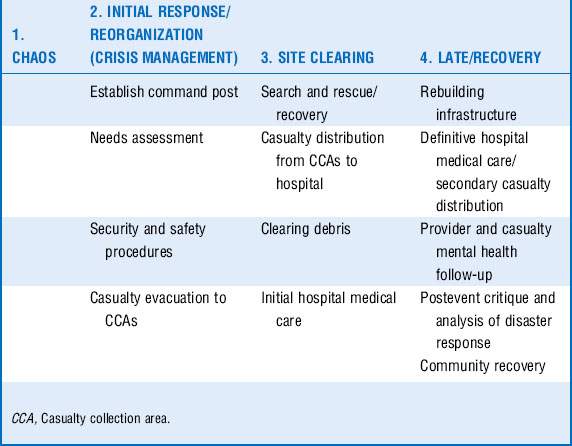Chapter 74 Disaster Medicine
Impact On Critical Care Operations
2 What are the most commonly encountered disasters?
Hurricanes, earthquakes, industrial accidents, acts of terror
3 How does the public health sector plan for disaster medicine–related events?
The Department of Homeland Security (DHS) in conjunction with the Department of Health and Human Services (HHS) bears a prominent role in the National Response Plans of the federal government. In the National Preparedness Guidelines issued by the DHS are listed 15 National Planning Scenarios (Box 74-1).
Box 74-1 United States National Planning Scenarios
From Department of Homeland Security: National Preparedness Guidelines September 2007: www.dhs.gov/xlibrary/assets/National_Preparedness_Guidelines.pdf.
For a comprehensive discussion of disaster planning from the level of the federal government please refer to the National Preparedness Guidelines website: www.dhs.gov/xlibrary/assets/National_Preparedness_Guidelines.pdf.
5 What are common categories of injuries encountered in the disaster victim?
 Cardiopulmonary: Commonly seen with inhalation agents such as mustard or blistering agents causing both a direct insult to pulmonary tissue(s) and indirect as a result of marked pulmonary edema with potential compromise of cardiac function.
Cardiopulmonary: Commonly seen with inhalation agents such as mustard or blistering agents causing both a direct insult to pulmonary tissue(s) and indirect as a result of marked pulmonary edema with potential compromise of cardiac function.
 Systemic (biologics or chemicals): Infectious agents, such as anthrax and smallpox, present obvious systemic effects, with an appreciable delay between exposure and manifestation of systems, thereby presenting a further challenge in timely therapy. Chemical agents (e.g., cyanide) with direct effects on cellular respiration and nerve gases (e.g., sarin) by inhibition of acetylcholinesterase exhibit systemic effects ranging from respiratory collapse to paralysis.
Systemic (biologics or chemicals): Infectious agents, such as anthrax and smallpox, present obvious systemic effects, with an appreciable delay between exposure and manifestation of systems, thereby presenting a further challenge in timely therapy. Chemical agents (e.g., cyanide) with direct effects on cellular respiration and nerve gases (e.g., sarin) by inhibition of acetylcholinesterase exhibit systemic effects ranging from respiratory collapse to paralysis.
7 What are the four categories of blast injury?
 Primary: Injuries resulting from the overpressurization wave that affects gas-filled structures such as the lungs, gastrointestinal tract, and middle ear
Primary: Injuries resulting from the overpressurization wave that affects gas-filled structures such as the lungs, gastrointestinal tract, and middle ear
 Secondary: Injuries resulting from flying debris affecting any body part
Secondary: Injuries resulting from flying debris affecting any body part
 Tertiary: Resultant injuries from personnel being thrown by the blast wind
Tertiary: Resultant injuries from personnel being thrown by the blast wind
 Quaternary: Exacerbations from existing conditions (i.e., chronic obstructive pulmonary disease exacerbations, myocardial infarctions) or complications from blast injuries (i.e., burns, crush injuries, closed head injuries)
Quaternary: Exacerbations from existing conditions (i.e., chronic obstructive pulmonary disease exacerbations, myocardial infarctions) or complications from blast injuries (i.e., burns, crush injuries, closed head injuries)
8 Describe blast lung.
 Lung injury is a result of a blast wave passing through lung tissue, causing tissue disruption at the capillary-alveolar interface. Effectively a pulmonary contusion caused by the traversing of a shock wave (associated with a blast) through the various structures of the lung, the process can be magnified as a result of the blast occurring in a confined structure thereby magnifying the effect with the pressure wave rebounding from the walls, floor, and ceiling. This type of injury may be mimicked by a shotgun blast to the thorax; however, injuries associated with high-velocity projectiles and knives do not present a similar pattern of injury.
Lung injury is a result of a blast wave passing through lung tissue, causing tissue disruption at the capillary-alveolar interface. Effectively a pulmonary contusion caused by the traversing of a shock wave (associated with a blast) through the various structures of the lung, the process can be magnified as a result of the blast occurring in a confined structure thereby magnifying the effect with the pressure wave rebounding from the walls, floor, and ceiling. This type of injury may be mimicked by a shotgun blast to the thorax; however, injuries associated with high-velocity projectiles and knives do not present a similar pattern of injury.
 Blast lung is clinically diagnosed by the presence of respiratory distress, hypoxia, and butterfly or batwing infiltrates (perihilar infiltrates caused by the reflection of the blast wave of mediastinal structures).
Blast lung is clinically diagnosed by the presence of respiratory distress, hypoxia, and butterfly or batwing infiltrates (perihilar infiltrates caused by the reflection of the blast wave of mediastinal structures).
 If patients require mechanical ventilation, the Acute Respiratory Distress Syndrome Network (ARDSNet) protocol is appropriate.
If patients require mechanical ventilation, the Acute Respiratory Distress Syndrome Network (ARDSNet) protocol is appropriate.
Stay updated, free articles. Join our Telegram channel

Full access? Get Clinical Tree






